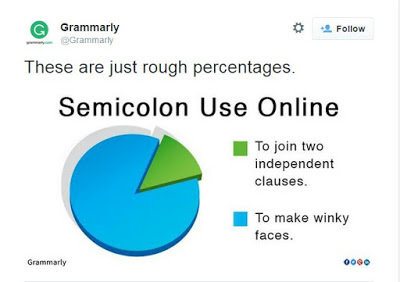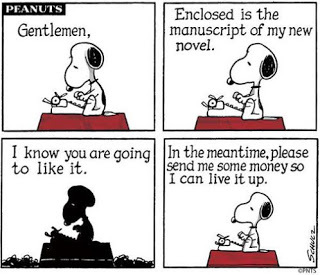Marty Halpern's Blog, page 20
August 26, 2015
Book Received: Led Astray: The Best of Kelley Armstrong
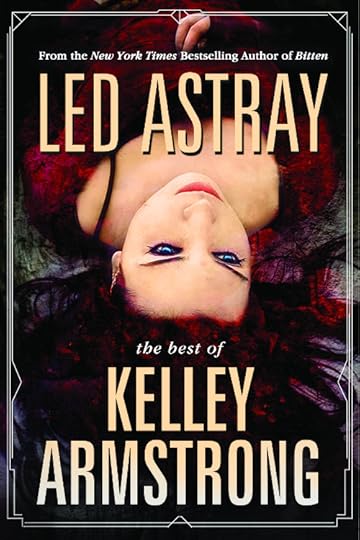 One of the best aspects of my job is receiving the finished product -- the published book -- after having worked so hard on the project, either as the editor, copy editor, proofreader, or all of the above.
One of the best aspects of my job is receiving the finished product -- the published book -- after having worked so hard on the project, either as the editor, copy editor, proofreader, or all of the above.This is how I began my June 30, 2015, blog post when I first wrote about my work on this collection:
* * *So, what does 148,000 words of short fiction physically look like? A stack of manuscript pages 2¼ inches high; or 530 pages, to be exact!Well, September is now -- Tachyon Publications, unlike the majority of independent presses, always ships ahead of schedule -- my comp copies of Led Astray arrived this past week. And those original 2¼ inches of manuscript pages? They became 535 layout pages in the published trade paperback edition.
That's the size of the manuscript for "the best of" short story collection Led Astrayby Kelley Armstrong, forthcoming in September from Tachyon Publications.* * *
For those not acquainted with Ms. Armstrong's work, her novels have made her a #1 New York Times bestselling author -- and the stories in Led Astray are a great starting point for new readers, since you get a taste of her many worlds. And as for seasoned readers, these stories will add depth to those worlds you are already familiar with.
Here's an excerpt from one review, courtesy of Net Galley:
...This is how fairy tales used to be ― grim and harsh. In this collection of over 20 short stories, Ms. Armstrong demonstrates over and over again how she is a master of her craft... Many of the stories have no happily ever afters or even a happily for now. Instead, it seems the warning is clear ― be careful of what you wish for. For those who have never read a Ms. Armstrong book, this collection can be read as a standalone. A few of the stories do tie in to her different series. The tie-ins enhance the world-building for those hooked on the various series. For those new to Ms. Armstrong, it will cause the new reader to salivate and rush to read all her series. This first-rate [collection] could be devoured in one sitting. It's best to savour each story by itself. The deferred gratification by slowly consuming each story...makes this painfully pleasurable book last longer... It's tightly focused with nary a wasted word. The constant haunting gloomy feel keeps a reader on edge. The expressive descriptions of the places set the somber mood. The intriguing situations lure a reader into a bit of complacency before the trap is sprung. The endings to several of the pieces are gruesome and I reveled in it. Many times, it seems the villain wins the day. This is very different than most books and for this refreshing take, I applaud Ms. Armstrong. I particularly enjoyed the twists and turns in the stories... It makes the stories unpredictable...being off balance is exhilarating. There is a certain horror aspect to several of these stories... This book is highly recommended to those who enjoy darkness and things that go bump in the night.~ La Crimson F
Led Astray: The Best of Kelley Armstrong
 can now be ordered from Amazon, or from your favorite bookseller.
can now be ordered from Amazon, or from your favorite bookseller.
Published on August 26, 2015 15:02
August 24, 2015
Annie Proulx on Writing and Reading
You should write because you love the shape of stories and sentences and the creation of different words on a page. Writing comes from reading, and reading is the finest teacher of how to write.~Annie Proulx
(via Goodreads)

Published on August 24, 2015 11:26
August 19, 2015
Book Received: The King's Justice: Two Novellas by Stephen R. Donaldson
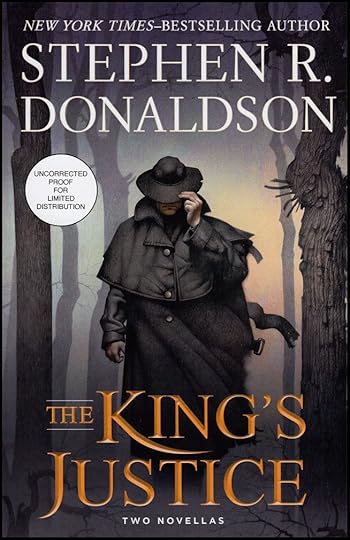 My presence online has been quiet of late as I have been working on a 219,000-word novel -- Courtney Schafer's The Labyrinth of Flame, book three in her Shattered Sigil trilogy. This is the largest book I've worked on in a few years, and it's been quite the major project. I'll be talking about my work on this novel shortly.
My presence online has been quiet of late as I have been working on a 219,000-word novel -- Courtney Schafer's The Labyrinth of Flame, book three in her Shattered Sigil trilogy. This is the largest book I've worked on in a few years, and it's been quite the major project. I'll be talking about my work on this novel shortly.When I wasn't working on Labyrinth, I was catching up on TV shows (Mr. Robot, Humans, Halt and Catch Fire, Defiance, Proof, and probably a few others. And, I've also been creating a database listing of all my vinyl albums using Discogs.com. I haven't played an actual LP in probably ten-plus years and, unfortunately, my turntable (a classic Concept 2QD) remained idle during all that time as well. The tone arm was frozen and thus the turntable had to be serviced: so, a huge shout-out to SerTech Electronics in San Jose, one of only three such service and repair centers in all the Bay Area. Their work queue is at least three weeks long, but by the end of the fourth week they had completed work on my turntable. Now all is right with the world.
Recently I received Stephen R. Donaldson's The King's Justice: Two Novellas
 . I actually won this book in a giveaway courtesy of SFSignal.com and the publisher, G. P. Putnam's Sons. If you are reading this blog, then I assume you are also a reader of science fiction, fantasy, and other genres, which also means you are probably familiar with SFSignal. (If not, then get ye mouse to that site immediately!) JP Frantz and John DeNardo have been running SFSignal since as far back as I can remember. The site is one of the best for news and reviews, cover reveals, interviews, mind melds, TOC listings, and more. And they do a lot of print and ebook giveaways as well.
. I actually won this book in a giveaway courtesy of SFSignal.com and the publisher, G. P. Putnam's Sons. If you are reading this blog, then I assume you are also a reader of science fiction, fantasy, and other genres, which also means you are probably familiar with SFSignal. (If not, then get ye mouse to that site immediately!) JP Frantz and John DeNardo have been running SFSignal since as far back as I can remember. The site is one of the best for news and reviews, cover reveals, interviews, mind melds, TOC listings, and more. And they do a lot of print and ebook giveaways as well.I had quite the time reading the first six volumes in Donaldson's Thomas Covenant series, which I wrote about in my October 27, 2013, blog post. In that post I had received The Last Dark
 hardcover, the fourth and final volume in Donaldson's The Last Chronicles of Thomas Covenant. I still haven't read those final four books yet (I'm currently reading the equivalent of HBO's season 5 of George R. R. Martin's The Game of Thrones), but as you can see I'm a fan of Stephen R. Donaldson's work.
hardcover, the fourth and final volume in Donaldson's The Last Chronicles of Thomas Covenant. I still haven't read those final four books yet (I'm currently reading the equivalent of HBO's season 5 of George R. R. Martin's The Game of Thrones), but as you can see I'm a fan of Stephen R. Donaldson's work.So go support SFSignal with your page views and Likes; and go read some Stephen R. Donaldson, too.

Published on August 19, 2015 16:31
August 3, 2015
Book Received: Nalo Hopkinson's Falling in Love with Hominids
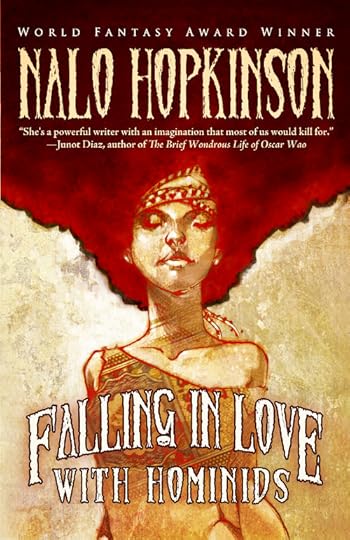 Whenever a package arrives on my doorstep -- most often by the US mail delivery person, but occasionally after one hears the sounds of the UPS truck pull to a stop or, rarely, another delivery truck (FedEx, typically) -- there's a little hint of the feelings of childhood, the memories of Christmas -- and presents. Yes, even if I paid for it, a package arriving on the doorstep, for whatever reason, always feels like a gift!
Whenever a package arrives on my doorstep -- most often by the US mail delivery person, but occasionally after one hears the sounds of the UPS truck pull to a stop or, rarely, another delivery truck (FedEx, typically) -- there's a little hint of the feelings of childhood, the memories of Christmas -- and presents. Yes, even if I paid for it, a package arriving on the doorstep, for whatever reason, always feels like a gift!The other day a USPS package arrived bearing my comp copies of Nalo Hopkinson's Falling in Love with Hominids
 , recently published by Tachyon Publications. And, indeed, it was a gift -- and in so many ways.
, recently published by Tachyon Publications. And, indeed, it was a gift -- and in so many ways.Here's an excerpt from Abigail Ortlieb's review for RT Book Reviews:
There is something especially exhilarating about Hopkinson's short stories. Her voice is fluid and always adds to the type of story she is telling, bringing to mind writers like Ray Bradbury ("The Easthound") or Toni Morrison ("A Young Candy Daughter"). Her Caribbean heritage is reflected beautifully in the prose, and each story is entirely distinctive. She prefaces each one with a dedication or tidbit about how or why that story was written, adding extra depth. If you haven't read any of her other works, you will be scrambling to after you read Falling in Love with Hominids. It’s a treasure trove of short gems by an immensely popular and talented writer. ~RT Book ReviewsYou can also read my April 14 blog post in which I write about my work on Hopkinson's Falling in Love with Hominids; the post includes a list of the 18 stories (one original to the collection) included in the book.
Here's one final excerpt from the Publishers Weekly review:
The stories all share a common thread of magic, which is often woven, whether subtly or blatantly, into the fabric of everyday reality, allowing characters to react to the strange or the impossible as it crosses into their world. Hopkinson also draws frequently on her Caribbean upbringing and heritage, and her characters' voices are distinct and authentic, both in their speech patterns and in their ways of looking at their surroundings. Hopkinson's fans will be delighted by these examples of her wide-ranging imagination.~Publishers Weekly
Falling in Love with Hominids
 can now be ordered from Amazon, or from your favorite bookseller.
can now be ordered from Amazon, or from your favorite bookseller.
Published on August 03, 2015 16:33
July 21, 2015
"Some readers may find themselves thrown off balance by the juxtaposition of beauty and ugliness—"
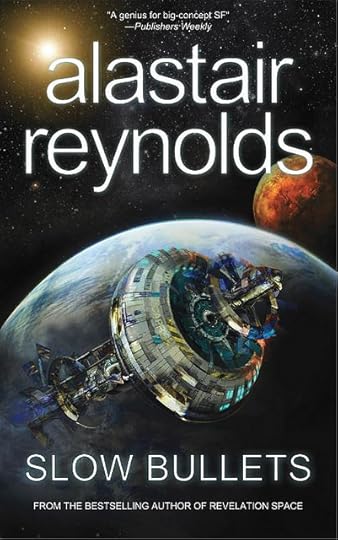 As a follow-up to the
Green Man Review
of
Slow Bullets
As a follow-up to the
Green Man Review
of
Slow Bullets
 that I posted on June 8....
that I posted on June 8....Let me repeat a brief paragraph that I wrote at the beginning of that June 8 blog post: If you are unfamiliar with the various works of author Alastair Reynolds, then Slow Bullets would be the perfect starting point. If you read Alastair Reynolds already, preferring his longer novels and series work -- still, don't deny yourself the pleasure of reading this story, as Slow Bullets has more ideas than some novels that are twice its length.
And if you doubt, or question, my words, here's a few excerpts from the very lengthy review of Slow Bullets from the Los Angeles Review of Books. The review, by Stan Hunter Kranc, is entitled "The Persistence (and Failure) of Memory":
Alastair Reynolds's Slow Bullets opens with poetry and a war crime.
The poet is Giresun, the fictional poet laureate for the Central Worlds, one side in a bloody sectarian conflict. Although the novel's narrator, a former soldier called Scur, fought instead for the Peripheral Systems (where reading the enemy's "propaganda" was illegal), the poet was especially meaningful to her family and to the soldier herself as a link to long-lost loved ones.
The war crime is perpetrated at the conflict's end: Scur grimly reports her own capture and subsequent torture by a group of renegade soldiers, led by the infamous war criminal Orvin. Though the details evoke a rape, the instrument of Scur's torment is technological: the slow bullets that give the novella its name.
Readers unfamiliar with the larger body of the Reynolds's work — a dozen novels and an impressive number of short stories, novellas, and collections — may be startled by the prose, which is disarmingly clinical, punctuated by instances of visceral phrasing. Some readers may find themselves thrown off balance by the juxtaposition of beauty and ugliness — or by the abrupt shift in circumstances that immediately follows: Scur awakens on an apparently derelict ship, surrounded by feuding soldiers from both sides of the conflict, and with no memory of how she came to be there. Readers familiar with Reynolds's work, however, will know that these two threads must be intertwined. Reynolds is practiced in tying together apparently unrelated elements, and by the end of the story, the text irrevocably links bullet and poet.
...
Slow Bullets, however, marks a development in Reynolds's writing. As a storyteller, we see him experimenting with both the form and manner of narrative. We come to understand that the text's "flaws" (that it is often repetitive and sometimes obtuse) are deliberate artifacts of its narration, a glimpse into the inner workings of Scur's mind and motivations. As a writer, we see a more overtly thoughtful work examining the philosophical, technological, and social issues of memory. Most immediately, Scur is haunted by memories of lost family, Giresun's verse, and Orvin's torment. The war criminal is hiding somewhere aboard the ship, and Scur's quest for vengeance quickly draws in others. However, Orvin is not the only such criminal. With the exception of the hopelessly outnumbered ship's crew and civilian population, all aboard are dressed identically, and although it is known some are honest veterans and some are prisoners, the ability to distinguish friend from foe and good from wicked is a separate problem of memory.
...
Like so much of Reynolds's other writing, the message of Slow Bullets is ultimately ambivalent. Although Reynolds excels at weaving different threads together, his knots are convoluted, difficult things. Again, were this an "old" space opera, Scur's exploits in unifying the crew and forging a tentative peace would be heroic. Instead, a twist or two at the end reminds the reader that Reynolds is too pragmatic to write anything so unequivocal. Slow Bullets is a story of revenge and redemption, high-tech problems and low-tech solutions, and the preservation of memory through surrendering the past — the failure to forgive but the possibility to forget.
Please read the full review at the Los Angeles Review of Books online. And, you can also read of my work on Slow Bullets in my "Editing in Process" blog post.

Published on July 21, 2015 12:31
July 6, 2015
Statistics on Semicolon Use
Published on July 06, 2015 09:57
July 3, 2015
Charles M. Schulz on Writing and Publishing
Published on July 03, 2015 18:04
July 2, 2015
Excerpt Link: The Annihilation Score by Charles Stross
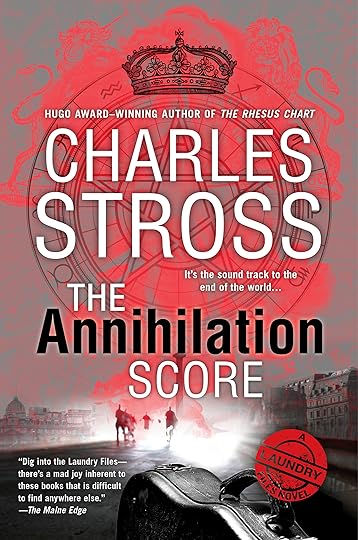 The Annihilation Score
The Annihilation Score
 is the sixth book in Charles Stross's Laundry Files series, which will be released this coming week. In my "Editing in Process" blog post of March 26, I detailed some of my work on The Annihilation Score as well as the previous five books in the series.
is the sixth book in Charles Stross's Laundry Files series, which will be released this coming week. In my "Editing in Process" blog post of March 26, I detailed some of my work on The Annihilation Score as well as the previous five books in the series.The Laundry is a supersecret British intelligence agency that protects and defends Her Majesty's Government, and the people of England, from occult incursions from beyond space-time. In the books, we follow two agents: Bob Howard and Dr. Dominique "Mo" O'Brien. Up to this point, the Laundry Files stories have all been from Bob's point of view, but The Annihilation Score turns the storytelling on its head, and we now get to experience Mo's pov; her story begins at the end of the events in The Rhesus Chart
 . Here's a bit of an introduction, courtesy of the author and Tor.com.
. Here's a bit of an introduction, courtesy of the author and Tor.com.Dominique O'Brien—her friends call her Mo—lives a curious double life with her husband, Bob Howard. To the average civilian, they're boring middle-aged civil servants. But within the labyrinthian secret circles of Her Majesty's government, they're operatives working for the nation's occult security service known as the Laundry, charged with defending Britain against dark supernatural forces threatening humanity.In anticipation of the release of The Annihilation Score on July 7, Charles Stross and Tor.com have posted the first two chapters of the novel for your advanced reading pleasure. Chapter One is entitled "Prologue: the Incorrigibles" and Chapter Two is "Morning After." Read the excerpt from The Annihilation Score on Tor.com
Mo's latest assignment is assisting the police in containing an unusual outbreak: ordinary citizens suddenly imbued with extraordinary abilities of the super-powered kind. Unfortunately these people prefer playing super-pranks instead of super-heroics. The Mayor of London being levitated by a dumpy man in Trafalgar Square would normally be a source of shared amusement for Mo and Bob, but they're currently separated because something's come between them—something evil.
An antique violin, an Erich [Zahn] original, made of human white bone, was designed to produce music capable of slaughtering demons. Mo is the custodian of this unholy instrument. It invades her dreams and yearns for the blood of her colleagues—and her husband. And despite Mo's proficiency as a world class violinist, it cannot be controlled...

Published on July 02, 2015 10:57
June 30, 2015
Editing in Process... Led Astray: The Best of Kelley Armstrong
 Cover art by Liliana SanchesSo, what does 148,000 words of short fiction physically look like? A stack of manuscript pages 2¼ inches high; or 530 pages, to be exact!
Cover art by Liliana SanchesSo, what does 148,000 words of short fiction physically look like? A stack of manuscript pages 2¼ inches high; or 530 pages, to be exact!That's the size of the manuscript "for the best of" short story collection Led Astray
 by Kelley Armstrong, forthcoming in September from Tachyon Publications.
by Kelley Armstrong, forthcoming in September from Tachyon Publications.Now, I haven't read a lot of Kelley Armstrong's fiction. Just a few stories, no novels. I'm not an "urban fantasy, werewolves-vampires-zombies" kind of guy. During my years working with Night Shade Books[1], I worked on a couple Kelley Armstrong stories: "Twilight" in By Blood We Live (2009) and "Last Stand" (also included in Led Astray) in The Living Dead 2 (2010), both anthologies edited by John Joseph Adams. And one other story, "A Haunted House of Her Own" in The Urban Fantasy Anthology, edited by Peter S. Beagle and Joe R. Lansdale, from Tachyon Publications (2011)[2].
To say I was surprised when I began working on the stories in Led Astray would be an understatement. I'm still not an "urban fantasy, werewolves-vampires-zombies" kind of guy, but I will definitely be reading more Kelley Armstrong stories in the future. What I discovered is that a number of the stories are written within Ms. Armstrong's existing series' universes -- actually only ten of the collection's twenty-three stories are "standalone"; all the rest fall within her existing series. So I would read a very cool story like "Learning Curve," and then six stories later I would encounter some of the same characters in "The List." The characters are so deftly written that when I came upon them again in another story it was like meeting up with old friends already.
One of my favorites, albeit a standalone story, is "Last Stand" -- unexpectedly, at least for me, a zombie story! It's a typical zombie story, in one sense: following a virus outbreak, soldiers in a fort must fight for their survival against the "Others." The well-drawn, strong female protagonist, Monica Roth, was a chemistry teacher before the outbreak, and now serves as commander, doing her best to keep the "last band of resistance fighters" alive. Here are a couple excerpts:
Before [Gareth] could say a word, she lifted her hand."Objection noted, Lieutenant.""I didn't say a word, Commander," he said."You don't need to. You heard we're bringing in a fresh lot, and you're going to tell me—again—that we can't handle more prisoners. The stockade is overcrowded. We're wasting manpower guarding them. We're wasting doctors caring for them. We should take them out into the field, kill them and leave the corpses on spikes for the Others to see.""I don't believe I've suggested that last part. Brilliant idea, though. I'll send a troop to find the wood for the poles—"She shot him a look. He only grinned.How "Last Stand" differs from the typical zombie story is...well, let's just say if I tell you, then I will completely spoil the experience of reading this story. You're just going to have to trust me on this one: go order Led Astray: The Best of Kelley Armstrong from Amazon
[. . .]
The H5N3 virus had started in Indonesia, with sporadic outbreaks downplayed by authorities until they could announce a vaccine.Their salvation turned into their damnation. Some said the vaccine had been deliberately tampered with. Others blamed improper testing. They knew only that it didn't work.No, that wasn't true. If the goal was to ensure that people survived the flu, then it worked perfectly. People were vaccinated, they caught the virus, they died, and they rose again. Even before they rose, though, they'd carried a virus of their own, unknowingly spreading it through lovers, drug use, and blood donations. By the time officials realized the problem, a quarter of the population was infected. After the vaccinations stopped, another quarter died from the influenza itself. Both viruses continued to spread.That was the Great Divide. The human race sliced in two, one side fighting for supremacy, the other for survival.
 or wherever you prefer to purchase books, and read this story -- and the twenty-two others in the collection -- and be amazed. Of course, if you are already a fan of Ms. Armstrong's work then I'm not telling you anything you don't already know!
or wherever you prefer to purchase books, and read this story -- and the twenty-two others in the collection -- and be amazed. Of course, if you are already a fan of Ms. Armstrong's work then I'm not telling you anything you don't already know!This is the table of contents as it appears in the manuscript, with the respective universes noted where applicable. Of the twenty-three included stories, two are original to this collection.
Rakshashi (standalone)Seventeen of these stories have been reprinted from anthologies, so I suspect even avid readers of Kelly Armstrong's fiction will not have seen most, if not all, of these stories. So no need to purchase seventeen other volumes...you can read the best of Kelley Armstrong in Led Astray.
Kat (Darkest Powers universe)
A Haunted House of Her Own (standalone)
Learning Curve (Otherworld universe)
The Screams of Dragons (Cainsville universe)
The Kitsune's Nine Tales (Age of Legends universe)
Last Stand (standalone)
Bamboozled (Otherworld universe)
Branded (Otherworld universe)
The List (Otherworld universe)
Young Bloods (Otherworld universe)
The Door (standalone, original to this collection)
Dead Flowers by a Roadside (standalone)
Suffer the Children (standalone)
The Collector (standalone)
Gabriel's Gargoyles (Cainsville universe)
Harbinger (standalone)
V Plates (Otherworld universe)
Life Sentence (Otherworld universe)
Plan B (standalone)
The Hunt (Cainsville universe)
Dead to Me (standalone)
Devil May Care (Cainsville universe, original to this collection)
---------------Footnotes
[1] You can read my diatribe "Doin' Hard Time at Night Shade Books," which includes a complete list of the more than 100 books I worked on during my time with the press.
[2] I just realized that I have now worked for Tachyon Publications for more years than I did Night Shade Books -- I believe my first project was in 2002; and considering it has all been contract work through the years, I have no complaints. The working relationship has been one of the best, and I hope it continues for many years to come. Led Astray is my most recent copy editing project; Slow Bullets by Alastair Reynolds was my most recent editorial project, which you can read about in detail here.

Published on June 30, 2015 15:20
June 12, 2015
Links: "How to Find the Right Critique Group or Partner"
"There's an element of searching and an element of matching. You're looking for people you can share a piece of your creative self with, for people you want to spend time on, for people who can help you become a stronger writer—a tribe or community. So a good fit is important."
The above is from Brooke McIntyre, founder of Inked Voices, a site where writers workshop in small, private online groups. She has a guest blog post entitled "How to Find the Right Critique Group or Partner for You" (June 10, 2015) on JaneFriedman.com.
I have to admit, it's one of the best posts I've read in recent memory on critique/partner groups. And what makes this post even more valuable is that Ms. McIntyre links to networking opportunities, online critique sites, review communities, and more.
Here are the topics covered in the post:
A. What to Look For in a Partner or Group1. Shared Direction, Similar Stage2. A Workable Pace3. People Enjoy the Writing and Feel Comfortable Critiquing It
B. So, How Do You Go About Actually Finding One of These Groups?1. Writing Associations2. Conferences and Retreats3. Meetup4. Participate in a "Mo"5. Other Networking Opportunities 6. Online Critique Sites7. Review Communities8. Email and WordPress Groups
Even if you already participate in a critique group, I suspect you'll find some worthwhile tidbits in this post. So check it out on JaneFriedman.com. One caveat, however: Both Jane Friedman and Brooke McIntyre are in the editor-for-hire business (Aren't we all?) so they do tend to mention their own products when the opportunity arises.

Published on June 12, 2015 14:51

